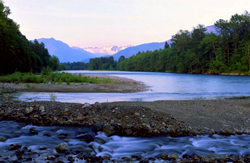Skagit Wild and Scenic River System


The Skagit Wild and Scenic River System is managed to protect and enhance the free-flowing condition, water quality and outstanding values for which the river was designated, while providing for public recreation and resource uses that do not adversely impact or degrade those values.
Beginning high in the North Cascade Mountain Range, the Skagit Wild and Scenic River winds down steep slopes, through forested hillsides and wide, open valleys eventually reaching Puget Sound. The rivers of the Skagit System (Skagit, Sauk, Suiattle and Cascade) flow through rugged wilderness, forestlands, rural communities, farmlands and cities of the lower Skagit Valley. The rivers are vital to valley residents and visitors, as the ebb and flow of moving waters influence their lives.
The essence of the river system reveals itself in abundant wildlife, exceptional fisheries, and outstanding scenery, qualities that make the Skagit an ideal component of the National Wild and Scenic Rivers System.
This website will help you discover the Skagit Wild and Scenic River System for yourself: what to do, where to do it, how to enjoy your stay in a safe and responsible way, and where to get additional information. This site also provides a brief discussion of river management and answers to your frequently asked questions. We welcome you to explore this marvelous treasure. We also encourage you to contact us by email or at any of our offices to find out more about our programs and management activities.
Private Lands Within the Wild and Scenic River
In the Skagit Wild and Scenic River System fifty percent of the designated corridor is in private ownership. The Forest Service does not have authority to regulate the use of private lands. As they were prior to designation, nonfederal lands remain subject to state and county laws and regulations. For more specific information check our FAQ page.
If you are planning a river-related project or repair we recommend that you contact the Washington State Department of Ecology Office of Regulatory Assistance, to determine what permits are necessary. The Forest Service is only involved in projects on private lands when the proposal is in the river’s bed or its banks and is assisted by another federal agency (e.g. technical assistance, funding, or permit). The Forest Service may also be involved in nonfederally assisted project proposals in the river’s bed or its banks or in upland activities (e.g. timber harvest) if we are requested to provide advice to another agency.
The role of the Forest Service on nonfederal lands is to monitor activities within the river corridor and, for any proposed activity that is likely to have adverse impacts on the values of the river system, to work cooperatively with state and local agencies, and landowner(s) to resolve. The Forest Service may provide technical assistance to find ways to alleviate or mitigate the potential threat. If state, county and local laws and regulations and/or technical assistance fail to protect river values, the Forest Service has the authority for limited purchase of private lands from willing sellers in fee title or a scenic or access easement.
Alerts & Warnings
- Mallardy Ridge Trailhead and FSR 4030 and 4032 Closure
- Harris Lake Trailhead and FSR 5510 Closed
- Middle Fork Camping Closure
- Delays possible on PCT at the Summit at Snoqualmie Ski Area
- FSR 4110 Road Closure
- Camping Restrictions
- Fireworks and Explosive Targets Prohibition
- Read this Before Climbing or Backpacking on Mt. Baker
- Hwy 542 Closed to Artist Point
- New food storage rules for Mt. Baker-Snoqualmie NF
- Alcohol Prohibitions

